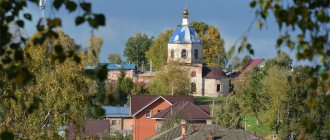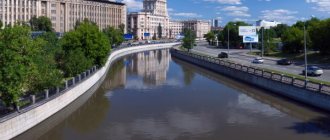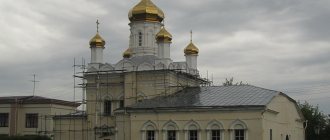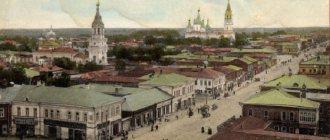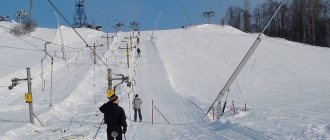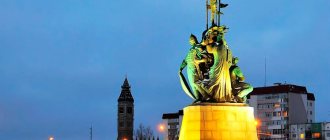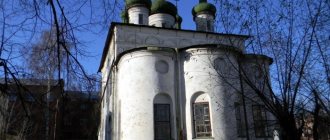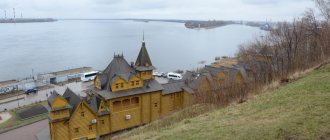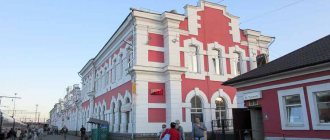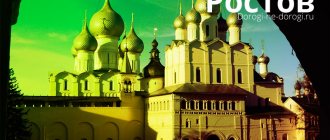Pechory is a small town in the Pskov region, located almost on the border with Estonia. The very name “Pechory” translated from the Old Church Slavonic language means “caves”. And this is no coincidence, since the entire history of the city is in one way or another connected with this geographical object. The cave is displayed as a symbol of the city on its coat of arms, and Pechory itself owes its origin to the Pskov-Pechersk Monastery, famous for its countless cave passages - the town was formed around the abbey at the end of the 15th century.
The monastery is considered the main attraction of the city, but besides it, Pechory has many other attractions that are no less significant in their cultural and historical past.
It was in the beauty of this region that famous Russian poets, historians and artists, such as Igor Severyanin, Nikolai Kostomarov and Karl Bryullov, drew inspiration. The city is literally replete with architectural creations, made in an endless stream of various styles, ranging from Ukrainian Baroque (Pokrovskaya Church), as well as buildings in the Empire style (Brotherly Corps), and ending with Russian classicism (St. Michael's Cathedral).
- What other interesting things are there around Pechory and on the way here? In a review of the main places in the Pskov region.
- A detailed guide to Pskov for those traveling from it to Pechory.
The importance of the city in the modern world
Pechory, whose attractions are ancient cathedrals and temples, is the administrative center of the Pechora district and an urban settlement called Pechory.
The first mention of a settlement located in this place dates back to 1392. The name of the settlement comes from the old Russian word “pechery”, which meant “caves”. From 1920 to 1940 the city was called Petseri.
The founding date of the settlement is considered to be 1472. At this time, an Orthodox priest named Ioan founded the first monastery on this site. This event was preceded by the destruction of Orthodox churches by the Germans in the city of Tartu (Dorpt).
In 1782, the settlement of Pechory, by order of Catherine II Alekseevna the Great, acquired the status of a city in the Pskov region. Pechory, along with the Kaliningrad region, is considered the westernmost Russian city. It is located 53 km from the regional center.
In the north and east of the city flows a small river called Pachkovka. This is one of the tributaries of the Pimzha River, as well as the basin of Lake Pskov. The length of the river is 19 km, the basin area is 82 km².
Geographic coordinates of the city: 65.14716 north latitude, 57.22439 east longitude. The city center is located at an altitude of 85 m above sea level. The total area of the city is 20.55 km².
The main events that took place in the city at different times:
| from the 16th century to the beginning of the 18th century | Pechory is the main strategic point in western Russia |
| 16th century | Knights - Catholics of Livonia destroyed the most ancient monastery of the city |
| from 1529 to 1570 | Temples are being restored and restored, watchtowers are being built and gates are being strengthened. |
| 1565 | By decree of Ivan the Terrible, the city of Pechora became part of the zemshchina |
| 1581 – 1582 | The siege of Pechora by King Stefan Batory of Poland takes place. |
| 1611 – 1616 | siege of Pechora by Polish and Swedish troops |
| 1701 – 1703 | second siege of Pechora by Swedish troops led by Charles XII |
| 01/09/1783 | city coat of arms approved |
| 01/11/1797 | Pechora district was liquidated |
| 08/04/1889 | railway traffic has been formed along the Pskov-Riga road, laid next to the city |
| 1899 | the first railway station was founded |
| 1914 | 2 primary ministerial educational institutions were organized in the city |
| 1918 | the city is occupied by German troops |
| 02/04/1919 | the city was conquered by the Estonians |
| 03/11/1919 | the city was liberated by the Red Army |
| 03/29/1919 | Estonians retake the city again |
| 1920 | the city is officially part of Estonia |
| 1931 | Pechory railway station becomes a railway junction |
| 05/24/1939 | A terrible fire destroys almost the entire city |
| 1940 | the city of Pechory, part of the Republic of Estonia, joined the USSR |
| 07/10/1941 | the city is occupied by Nazi Germany |
| 08/11/1944 | the city was liberated by Red Army soldiers |
| 08/23/1944 | Pechory is part of the RSFSR as part of the Pskov region |
| 2007 | Pechory is excluded from the list of border zones of the country |
Descent "Bloody Path"
Behind the arch of the monastery, the descent begins, which is nicknamed the “Bloody Path”. The decoding of this name is stored in one of the ancient manuscripts. In 1547, Tsar Ivan the Terrible visited the local region. He was met by Abbot Cornelius, the then abbot of the monastery. The king was angry with him for something and immediately cut his head.
However, at the same moment he regretted his action and in his own hands carried the deceased to the monastery along this very descent. After this event, he made large donations to the monastery. Rowan trees are planted along the edges of the path. And in the fall, red berries seem to remind of a past event.
Climate
Pechora, whose attractions are its unique flora and fauna, has a moderately cold climate. According to the comfort rating, July and August are considered the best months to travel.
Average air temperatures calculated taking into account the last few years:
| month | day °C | night °С | sunny days | precipitation in mm | wind speed in m/s | rainy days |
| January | -4,4 | -8,5 | 2 | 31,12 | 3,6 | 6 |
| February | -2,8 | -7,6 | 1 | 26,95 | 3,4 | 5 |
| March | +1,2 | -4,8 | 3 | 21,66 | 3,6 | 9 |
| April | +9,5 | +0,9 | 11 | 26,05 | 3,3 | 14 |
| May | +17,4 | +6,4 | 19 | 30,16 | 3,1 | 15 |
| June | +19,9 | +9,4 | 16 | 45,27 | 3,3 | 18 |
| July | +23,6 | +12,9 | 17 | 44,46 | 3,1 | 18 |
| August | +21,7 | +11,6 | 17 | 42,54 | 3,1 | 17 |
| September | +16,3 | +8,2 | 12 | 25,57 | 3,4 | 15 |
| October | +8 | +2,5 | 9 | 34,9 | 3,6 | 14 |
| november | +3,2 | +0,0 | 2 | 34,48 | 3,6 | 12 |
| December | -1,2 | -4,5 | 2 | 31,69 | 3,9 | 9 |
Ecology
Pechory, whose attractions attract many tourists, is located on the western side of the Pskov region.
The environmental situation in the Pskov region, and in particular in the city of Pechory, is not entirely favorable. The negative impact on the environment is caused by unauthorized dumping of industrial waste, an insufficient number of authorized landfills and the lack of waste recycling facilities.
The region's water resources are affected by wastewater discharges.
At the end of the last century, in the Pskov region there were burials of unusable agrochemicals and pesticides. The largest testing site was located in the Pskov region near the village of Korsakovo. In the town of Nevele there is an oil sludge storage facility, which has recently been in unsatisfactory condition.
Local residents of Pechora have repeatedly complained about the huge amount of hogweed that has filled the entire territory of the suburb. Every year, a huge number of people go to hospitals with complaints of external and internal burns from this plant.
Landscapes of the territory
The natural landscapes of the Upper Pechora valley are unique. Sights can be found along the entire route of its flow. The river flows between the ridges of the Ural Mountains, where the mountain waters of the Upper, Sr. flow into it. and N. Klyuchikov, Yurginskaya, Shchegolikhinskaya and other rivers. After the confluence of Manskaya Volosnitsa, the river changes direction sharply to the west. In the mountainous part, the river also flows into the river. Malaya Porozhnaya.
Then, at Bear Stone (mountain), after passing a long powerful rapid, Pechora flows out into the foothill area. The section of the channel from the mouth of B. Porozhnaya to Vysokaya Parma itself is about 150 meters wide and is a flat shoal, mostly lined with rather large pebbles, which makes it very difficult for boats to move in these places.
This section of Pechora is also interesting in terms of landscape. Natural attractions here are presented in the form of small islands, and therefore the river is divided into several branches. Below the confluence with the B. Shezhima River, relatively quiet reaches with small, rare riffles are quite common. And the number of islands further decreases, but their size increases.
Further, there is an expansion of the channel and the disappearance of the shallows, and just below the mouth of Bolshaya Shaitanovka, the Pechora already presents steep and large bends. On the border of the reserve (western) on the banks you can often observe large outcrops of limestone (especially at the mouth of the Bolshaya Shezhim River).
Population
According to the latest census (2021), the number of local residents was 9,670 people. The residential density in the city is 470.56 people per km².
Basically, the following people live on the territory of Pechora:
- Russians, almost 90%;
- Ukrainians – 3%;
- Belarusians – 1.5%;
- Estonians – 1.5%;
- Setu people – 0.5%.
Local residents are called:
- Pecheryans;
- Pecheryanin;
- pecheryanka
Seals
Seals in Pechory are a separate type of love. The first time I was walking along Novaya Street towards the park and saw one pussy crossing the road. My heart then sank, and thoughts swirled in my head: “Are you crazy? There are cars right there! Cross the road quickly.”
But the cat was in no hurry to get to the other side of the street. He sat down imposingly right in the middle of the road and began to wash himself. I stood for about 2 minutes and watched the cat so that he wouldn’t get hit by a car.
As it turns out, cats crossing the road are a fairly common phenomenon in Pechory. The population of the town is only 9,670 people as of January 1, 2021. Accordingly, there is little traffic there. So the cats manage as they please.
But to me, as a resident of a big city, it initially seemed very strange and dangerous for animals. Because in megacities they don’t always let people through, but here it’s a small beast. During 2 days of my travels, I met 5-6 of these cats, which were always (!) missed by drivers.
We even managed to shoot a video. This cat turned out to be cultured and crossed the road right at the pedestrian crossing.
Flora and fauna
The sights of a small town called Pechory are very diverse; the flora and fauna of the region are quite interesting.
The territory of Pechora is dominated by taiga and mixed forests, in which grow:
- linden and aspen;
- maple and elm;
- ash and birch;
- alder and willow;
- oak, pine and spruce.
Almost 1.5 thousand species of ferns and more than 80 species of mushrooms grow here. The fauna of the Pskov region is very rich.
Here you can find animals:
- wild bear and lynx;
- fox and ferret;
- beaver and muskrat;
- numerous rodents.
Of the amphibians and reptiles found:
- newts and toads;
- frogs and toads;
- copperheads, lizards and vipers.
About 40 species of fish live in local reservoirs:
- whitefish and crucian carp;
- pike perch and burbot;
- tench, bream and pike.
Here you can find rare endangered animals such as:
- muskrat and roe deer;
- mink and elk;
- raccoon dog and squirrel;
- hedgehog and weasel;
- hare and marten;
- deer, badger and yellow-throated mouse.
How to get there
Pechora, whose attractions include numerous sculptures and memorials, is adjacent to the Russian-Estonian border through two road crossings: Shumilkino and Kunichina Gora. There are several ways to get to Pechora.
By plane
Air terminals closest to the city:
- at a distance of 107.59 km – Usinsk airport;
- at a distance of 176.29 km is Vuktyl Airport.
By train
You can get to the city by rail. At a distance of 3 km from the city there is the Pechory-Pskovskaya railway station, where long- and short-distance trains stop.
By car
From almost anywhere in Russia, you can get to Pechora by car.
Don't miss the most popular article in the section: Metro Nizhny Novgorod. Diagram, map, description.
Types of transport in the city
The most popular and accessible form of transport in the city of Pechory is the bus. Every day numerous buses travel on the city roads along approved routes.
Numerous passenger transportation companies offer taxi services. You can order a car by phone, via the Internet, or catch a car on the city streets. Estimated taxi fare is from 10 rubles. per km. There is an hourly fare - from 200 rubles. in 1 hour.
The cost of landing is from 10 to 100 rubles. The minimum fare is 70 rubles. Transportation of large luggage from 50 rub. Cost of idle taxi car from 3 rubles. in a minute.
You can also rent a car without a driver. If you have documents (passport, driver's license), you must pay and arrange insurance. The cost of a car without a driver per day is from 800 rubles. The price depends on the duration of the rental and the brand of the car.
Main attractions
Numerous attractions are located in the city and its surroundings.
Religious buildings
https://www.youtube.com/watch?v=hf8ZlFmHQL8
The Pskov-Pechora Fortress is located at: st. Mezhdunarodnaya, building 5. The fortress, erected to protect the monastery, has an observation deck in the upper part. You can see the architectural landmark daily from 9:00 a.m. to 4:00 p.m.
Pechora Fortress - the main attraction of the city of Pechora
You can get to the territory of the Petrovsky Bastion by going down to the foot of the monastery, which is located behind the Pskov-Pechora fortress. The bastion was founded in the 16th – 17th centuries by order of Peter I, with the aim of defending the city during the Northern War.
The mansion of T. G. Rusakov is located at the address: Pskovskaya street, building 32. The mansion is an architectural structure in the neoclassical style. The wooden 2-story mansion has a stone basement. The mansion belonged to Rusakov, a well-known timber merchant in these parts.
Museums
The Museum of the History of the City of Pechora is located at: st. Mezhdunarodnaya, building 6. You can visit the museum from 11.00 to 18.00 Wed. – Sun., Mon. – Tue. weekend.
The cost of visiting the museum for an adult is 100 rubles, schoolchildren – 30 rubles, students and pensioners – 50 rubles. This is the oldest museum in the city, where you can get acquainted with exhibits telling about the cultural and historical life of the city.
Works of art by artists are exhibited here:
- N. Roerich;
- A. F. Shnyavina;
- L. A. Mikstaisa;
- P. D. Melnikova.
The museum organizes exhibitions:
- archaeological;
- ethnographic;
- visual arts;
- dedicated to ceramics and porcelain;
- exhibition of the history of Soviet times.
Location of the international cultural center: st. Svobody, building 29. The center is opened in the building of the “House of the People’s Druzhina”, which has a capacity of 250 places. Exhibitions and cultural events dedicated to the development and creative potential of Pechora’s youth are held here.
The Seto Estate Museum is located at the address: Sigovo village, Pechora district. The museum is open daily from 10.00 to 17.00. Ticket price for an adult is 20 rubles, for children and students – 10 rubles. The cost of group excursions is 500 rubles. This is the only museum in the world dedicated to the life and way of life of the Finno-Ugric Seto people.
The exhibits include:
- antique chests and chests;
- chests of drawers and decorations;
- items made from natural sheep wool;
- things made by the hands of blacksmiths of the Seto people.
Natural attractions
Lake Velye is located at a distance of 9 km in the south-west direction from the city of Izborg, Pechora district, Pskov region. This is a picturesque lake, which is considered a natural attraction of the region. The lake is surrounded by a dense forest of mixed tree species.
Under the buildings of the Pskov-Pechora Monastery there are Sacred Caves. The length of the underground caves is 200 m. The air temperature stays at +5 °C all year round. The caves are a kind of necropolis, where more than 10 thousand monks and lay people were buried in ancient times. There are no analogues of this cave in the world.
The Pechora River, flowing through the territory of the Pskov region, is the largest and most abundant river in the European North.
It flows between 2 mountain peaks called “Pechery-Talakh-Chakhl” and “Yengile-Chakhl”, which are located at an altitude of 296.8 m above sea level. The length of the river is 1,809 km, the drainage area is more than 320 thousand km². The general river basin consists of 35 thousand small rivers and more than 60 thousand lakes.
Monuments
The carriage of Empress Anna Ioannovna was installed on the territory of the Holy Dormition Monastery on the street. Mezhdunarodnaya, building 5. You can view the stroller for free, from 9.00 to 16.00 daily. The stroller was personally left at this place by Empress Anna herself during her trip to the Pskov land.
The monument to the street lamp was erected on December 10, 2011, the architect of the monument is Alexander Bushuev. Street lamps are a symbol of the city streets of Pechora; it was decided to install the monument on Oktyabrskaya Square.
The monument to the Venerable Cornelius Hegumen of Pskov-Pechora (killed by Ivan the Terrible) was installed on the street. Podgornaya, opposite the Holy Dormition Monastery. Date of installation of the monument: October 4, 2012
Pechory. Lutheran Church of St. Peter.
The Lutheran Church of St. Peter attracts special attention. This is the first Lutheran church on the southern border of Estonia, consecrated in 1926. Its name then was more authentic than today - Pechora Evangelical Lutheran Church of St. Peter. It was built on the initiative of citizens. The organ was also bought all over the world, in 1928, from the Estonian company Kriisa. It is called “romantic” because it was created according to all the canons of romanticism: it has a soft and deep sound and the ability to perform many different melodies. And the organ of the Lutheran church is one of ten historical organs preserved in Russia. From April to October, everyone is invited to organ music concerts. Ticket prices are low and all funds go to donations - despite its functionality, the instrument requires restoration.
Leisure
For lovers of active recreation, parachute jumping is organized in the city. The estimated cost of the jump is from 3.5 thousand rubles. up to 4 thousand rubles
There are numerous bicycle rental points in the city. A bicycle ride around the city will bring great pleasure to adults and children. Fishing master classes are regularly held on Lake Velje. Numerous fishermen from different cities and villages come here.
The lake is rich in fish:
- pike and roach;
- perch and crucian carp;
- bream and white bream.
Interesting places to relax with children
An interesting holiday for the whole family can be a boat trip to the Talab Islands, which are located in the southeast of Pskov Lake. In the city of Pechory you can rent a Segway (from 8 years old) or a hoverboard (5 years old).
Rental cost:
- 5 minutes. – 100 rub.;
- 10 min. – 200 rub.;
- 20 minutes. – 300 rub.
A trip to the Izborsky Ostrich eco-farm can be an excellent family vacation. The eco-farm is open daily from 10.00 to 19.00. Black African ostriches and reindeer are bred there.
Excursions
Tourists are offered a variety of excursions to the cities of the Pskov region.
Excursion to Pechory, Pskov-Pechora Monastery
The cost of the excursion is from 3 thousand rubles. per person. During the excursion, you will get acquainted with the 16th-century fortress and visit the Holy Dormition Monastery. Visit to the famous caves, which are located in the underground of the monastery. The price includes excursion support.
Meals and transportation are paid separately. Approximate duration of the excursion is 6 hours.
Excursion to the Talab Islands
The cost of the excursion is from 1.5 thousand rubles. up to 4.5 thousand rubles. per person. The islands are located 25 km from Pskov. During the boat excursion, a visit to the islands is provided. Belov and im. Flooded. Inspection of the Cathedral of St. Nicholas and the house of Elder Nikolai Guryanov. Also, a walk through the pine forest, gardens and swimming in Lake Pskov. The tour lasts approximately 4 hours to 8 hours.
Combined excursion “Pskov – Izborsk – Pechory”
The cost of the excursion is from 3 thousand rubles. per person. During the excursion, you will visit 3 cities in turn. Inspection and visit to the main religious attractions of the cities and a walk through historical places. Estimated tour time 10 hours.
Attractions in the surrounding area
30 km from Pechory is Izborsk, a city in which the famous Izborsk fortress, mentioned in the chronicles, is located. This is a wonderful monument of Pskov military architecture. The fortress grew from a small fortification built here in the 9th century, and is now part of a natural and architectural reserve. Powerful picturesque walls, watchtowers, and picturesque panoramas around make a strong impression on travelers. The fortress and the surrounding buildings have still preserved the original urban structure and are, in fact, an open-air ethnographic museum. You can get here along the Pskov - Riga highway.
30 km from Pechory is Izborsk, a city in which the famous Izborsk fortress, mentioned in the chronicles, is located.
Along the Riga Highway you can get to the ancient settlement of Kamno: the Great Valdai Glacier passed through this area approximately 10-12 thousand years ago, and the Kamenka River was formed. At the source of the river there is a settlement and the Church of St. George, built in the 15th century from local limestone. The temple is famous for its spring, the water of which - so they say - heals many diseases, both physical and spiritual.
Between Pechory and Izborsk, on the shores of Lake Malskoye, lie the village of Maly and the Malsky Nativity of the Savior Monastery, or Onufriev Hermitage. In addition, the Malskaya Valley is a habitat for birds during seasonal migrations and is simply a very beautiful place.
Route for exploring the city on your own in 1-2 days
In addition to excursion tours offered by travel agencies, it is advisable to prepare a route for independent movement around the city.
1 day stay in the city:
- Visit to the Holy Dormition monastery buildings.
- Inspection of the Holy Caves located under the monastery
- Inspection of the Empress's carriage.
- Visit to St. Michael's Cathedral.
- A trip to the Sagittarius house.
- Excursion to an eco-farm where ostriches are kept.
- Inspection of the lantern monument.
- Excursion to the water tower.
2nd day of stay in the city:
- Inspection of Rusakov's house.
- Excursion to the Pechora History Museum.
- Visit to an international cultural center.
- Visit to the Church of the Forty Martyrs of Sebaste.
- Excursion to the Seto Museum.
- Excursion to the Petrovsky Bastions.
- Trip to Pechora Lake.
Church of the Forty Martyrs
Recommend a place
1
The Church of the Forty Martyrs is located on a small area on the southwestern side of the Pechora fortress. In its plan, it represents a pronounced longitudinal-axial composition of the “octagon on a quadrangle” type. The main volume, which carries the drum and the dome, is adjoined from the east by the cylinder of the apse, and from the west by a rectangular refectory and a three-tiered square bell tower.
The volumetric-spatial composition of the monastery is characterized by the desire for verticalism, inherent in most tent-roofed buildings. The transverse ends of the temple cross are rounded and shortened. The decor of the building is quite modest - the apses, facades of the main volume, as well as the bell tower and refectory are decorated with pilasters (vertical wall projections). The head of the Church of the Forty Martyrs is completed by a decorative octagonal drum, which has a hemispherical shape and is topped with an apple.
Every year this place attracts thousands of tourists who want to personally enjoy the interior decoration of the 19th century that has been preserved here. The main attraction of the temple is the wooden altar decorated with decorative carvings. There is a special atmosphere here; after visiting the church, you will feel spiritual harmony and balance.
Hotels
Hotels of various price categories invite city guests.
Guest House "Pilgrim's Way"
The cost of a hotel room starts from 5.9 thousand rubles. per night. The hotel is located at: Pechory, st. Mezhdunarodnaya, house 10.
The hotel has 7 rooms, including:
- luxury;
- family;
- with kitchenette;
- for non-smokers.
The hotel offers:
- free parking and transfer from and to the airport;
- free internet and refrigerator in the room;
- concierge and microwave;
- Room service and shuttle bus.
Breakfast is available for an additional fee.
Hotel "12 months"
The cost of a hotel room is 1.7 thousand rubles. per night. The hotel is located at the address: Pechory, Oktyabrskaya Square, building 6. The hotel has 23 rooms, which are located in two adjacent buildings. There are standard rooms and superior rooms.
The hotel offers:
- restaurant and free parking;
- room service and free internet;
- showers and toilets on the floor (in standard rooms);
- cooler with hot and cold water (on the floor);
- refrigerator and electric kettle;
- Microwave and hair dryer;
- ironing board and iron.
Hotel Planet
Hotel location: Pechory, st. Mira, house 10. Room cost from 2 thousand rubles. per night.
The hotel offers its guests:
- free internet and refrigerator in the room;
- air conditioning and free parking;
- concierge and shuttle bus.
The hotel allows pets. The hotel has only 35 rooms, including non-smoking and family rooms.
Hotel "Pechory-Park"
The cost of a hotel room starts from 1.2 thousand per night. Hotel location: Pechory, st. Gagarina, house 2 "b".
The hotel has a total of 22 rooms, including:
- for non-smokers;
- family;
- luxury;
- rooms with kitchenette.
The hotel offers:
- bar and free parking;
- room service and free internet;
- restaurant and concierge;
- babysitting services and wheelchair ramps;
- refrigerator in the room and shuttle bus.
The hotel allows pets.
Hotel "Black Cat"
Price per hotel room from 1.7 thousand rubles. per night. The hotel is located at: Pechory, October Square, building 7. The hotel has only 5 rooms. There are non-smoking and family rooms.
The hotel offers:
- restaurant and conference room;
- free parking and room service;
- free internet and breakfast.
- banquet hall and air conditioning.
There are many buses
I think we need to start from the bus station. It is located at the address: Victory Square, building 2. A huge number of buses come and go here in different directions.
But in the neighboring building where the pharmacy is located, there is a parking lot for Niva LLC buses (route 350 Pskov-Pechory; in both directions). The company also provides transportation to Tartu. This is a separate carrier that transports people on its buses.
At the bus station in Pechory you cannot buy a ticket for route 350. But you can call the drivers a few minutes before departure or buy a ticket directly from them when the bus arrives at the parking lot.
Address: Victory Square, building 4.
I chose route 350 because I didn’t want to live in a minibus or a caravan. And Niva LLC has good big buses! If so, the schedule with numbers is here:
Checkpoint of the Soviet Union
The Pechory bus station is a small Soviet-style building in which everything has been preserved from the times when the Olympic bear sadly waved its plush paw at us in 1980.
At the bus station there is one ticket office, a toilet (22 rubles) and a couple of benches. This kingdom is ruled by a fluffy black leader. With an arrogant look, which is characteristic only of cats, he looks at each new guest who entered his abode to buy a ticket.
Address: Victory Square, building 2.
What to bring as a souvenir
The most popular souvenirs from the city of Pechora:
- goods purchased at the monastery;
- wicker items made of wicker and carved jewelry;
- various knitted sheep's wool clothing;
- printed gingerbread from the city of Izborsk;
- memorable souvenirs purchased at the Russian song festival in the city of Pechory;
- goods purchased from the Lutheran Church.
You can also purchase souvenirs in specialized stores:
- "Pskotsvet", on the street. ;
- “Flower and Gift Shop”, on Oktyabrya Square, building 6;
- “Pechorsky Souvenir”, on the street. Mezhdunarodnaya, building 2 "b".
The attractions of the small town of Pechora are numerous fortresses and temples. The city often became a target for foreign invaders, so the surviving structures are historically important objects protected by the state.
Author: Olga Zhanskaya
Article design: Vladimir the Great
Pskov-Pechersky Monastery.
In 1920, after the signing of the Tartu Peace, Pechory became Estonian territory. The next 20 years were calm and prosperous for the monastery, the buildings were restored, and a Theological Academy was opened in the monastery. But in 1940, Estonia became a Soviet republic. A year later, World War II arrived here. Retreating, the Germans took the monastery treasury to Riga and then to Germany. From there it was returned only in 1971. And the monastery library was brought from Tartu in 1991.
